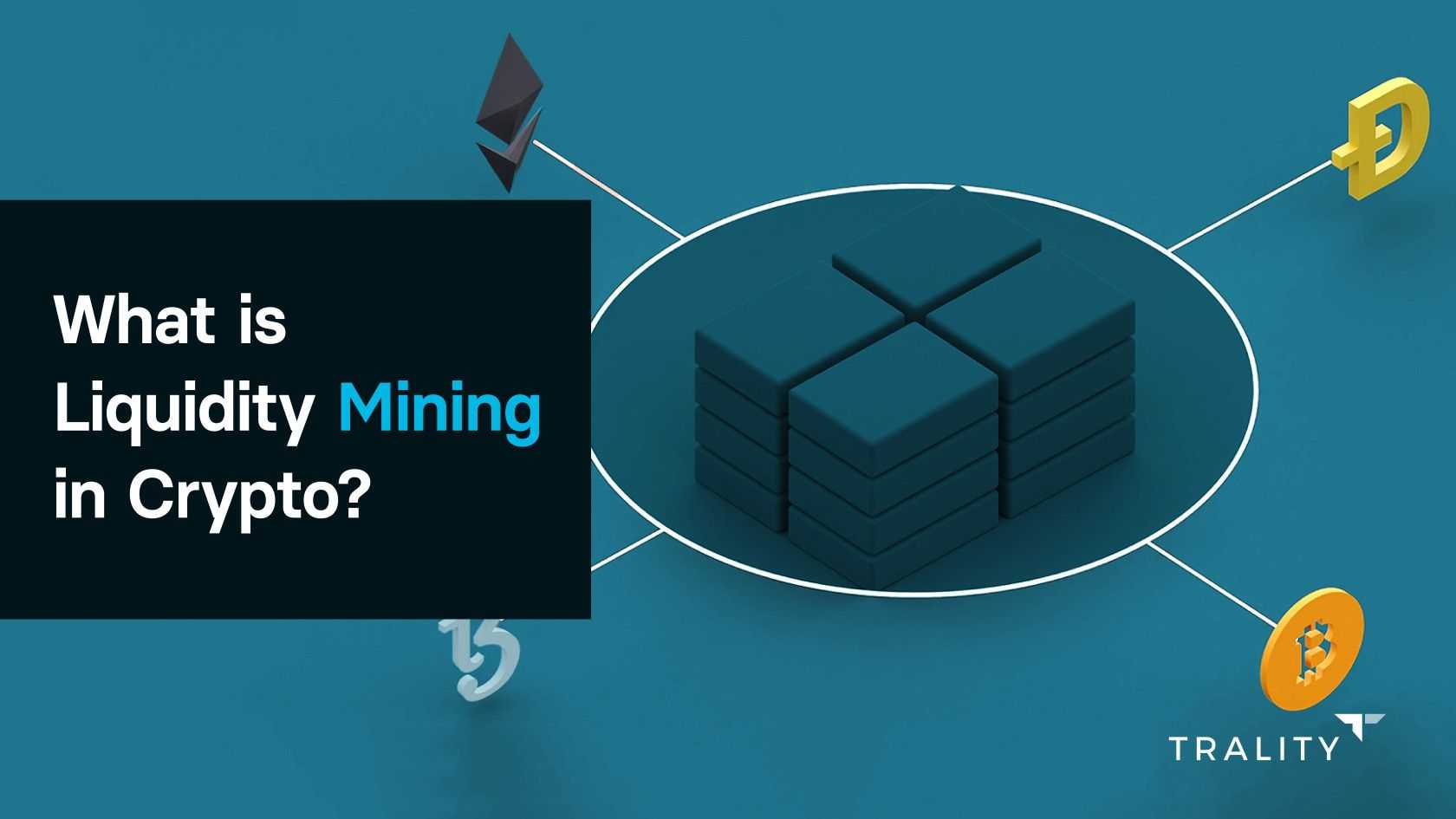What Is Liquidity Mining in Crypto?

MORITZ PUTZHAMMER
07 July 2022 • 7 min read

Table of contents
Prior to the emergence of decentralized finance (DeFi), owners of cryptocurrencies could only either hold or trade them to generate profits from their assets. However, the emergence of DeFi liquidity mining has been something of a game changer.
The story behind decentralized finance is an exciting and interesting one, and the field itself has spawned numerous innovative ideas, one of which is liquidity mining. Also known as DEX mining, DeFi mining, or DeFi liquidity mining, crypto liquidity mining is just one of many ways in which crypto users can put their assets to work for them.
In the following article, we’ll first examine what liquidity mining is and how it works before considering its relationship to DeFi, the advantages and disadvantages of liquidity mining, and even the differences between liquidity mining and staking.
What Is Liquidity Mining?
Liquidity mining is the practice of lending crypto assets to a decentralized exchange (DEX) in exchange for rewards. In this way, both the crypto exchange and token issuer reward the community for providing liquidity. This investment strategy is most commonly used by automated market makers (AMMs).
How liquidity mining works
Liquidity mining works by allowing participants to lock their assets into liquidity pools, which are shared pools. This type of pool typically contains liquidity in the form of tokens or coins, and it is exclusively accessible through DEXs.
DEXs are cryptocurrency exchanges that allow peer-to-peer transactions, eliminating the need for an intermediary like a bank. This form of exchange is completely self-contained and is run by algorithms and smart contracts.
Why liquidity mining is important
Liquidity mining is necessary because a DEX needs liquidity to allow trading between different token pairs. Using this investment strategy, users can then provide liquidity to facilitate these transactions. This also means that the vast majority of liquidity pools are between trading pairs, with users depositing one of two cryptocurrencies depending on the pool.
Once participants give liquidity to a liquidity pool, they can earn rewards. These rewards are known as “LP” (Liquidity Pool) rewards, and they are allocated among liquidity providers based on their pool share.
Liquidity Mining and DeFi
Any decentralized finance (DeFi) project has liquidity mining at its core. This is because liquidity pools are crucial parts of the DeFi ecosystem, especially for DEXs, as they provide liquidity, speed, and convenience.
Liquidity pools are locked in a smart contract and used to facilitate trades between assets on a DEX. Instead of traditional buyer-seller markets, many DeFi platforms use automated market makers (AMMs), which use liquidity pools to allow digital assets to be exchanged automatically and without authorization.
As mentioned, those who participate in liquid mining must deposit their assets into the crypto liquidity pool. In exchange, the liquidity mining protocol will give a Liquidity Provider (LP) Token to participants. This token acts as the depositor’s share in the pool. Participants can also use this token for different functions whether in the native platform or other DeFi apps.
Aside from the LP token they received, users are also rewarded with native or governance tokens, as long as their tokens remain in the liquidity pool. These newly generated tokens give them access to the project's governance and may be traded for greater rewards and even other crypto assets.
Crypto market liquidity was a problem for DEXs on Ethereum before AMMs came into play. DEXs were a new technology with a complex interface at the time, and the number of buyers and sellers was low. As a result, finding enough users willing to trade regularly was challenging.
AMMs solved the liquidity problem by building liquidity pools and incentivizing liquidity providers to fill these pools with assets, entirely without the use of third-party intermediaries. The more assets a pool has, and the more liquidity it has, the easier it becomes to trade on decentralized exchanges.
Is Liquidity Mining a Good Idea?
Now that you know what liquidity mining is, the next step is to consider whether it is a good investment approach. Liquidity mining can be a good idea, especially since it’s extremely popular among investors as it generates passive revenue. This means that you can profit from liquidity mining without having to make active investment decisions. The following are some other advantages of liquidity mining in crypto.
Possibility of high yields
Taking greater risks frequently results in higher returns. For instance, when you provide two volatile crypto assets as liquidity, it may offer greater rewards than providing two stablecoins. Stablecoins do not substantially fluctuate in value, but volatile assets like Binance Coin (BNB), among many others, can fluctuate by 10% or more at any time.

Equal distribution of rewards
With liquidity mining, you also get the added bonus of the equal distribution of governance through native tokens. Before liquidity mining, the allocation of tokens was largely unjust and uneven. The developers of DeFi protocols would also often prioritize investment firms and ignore low-capital investors. This has all changed with the advent of liquidity mining.
Lower barriers to entry
Aside from an equal distribution of rewards to investors, liquidity mining has minimal barriers to entry, making it an ideal investment approach that can be beneficial to anyone. Liquidity mining will most likely allow you to provide any amount of liquidity. You will still get rewards in exchange, even if your assets are small. This is especially attractive to those who have always wanted to join the decentralized ecosystem but never had the means to do so.
Governance privileges
In liquidity mining, everyone can join regardless of their stake. They can also claim governance tokens and consequently vote on projects and other important decisions made by stakeholders. Liquidity mining allows for a more inclusive system to evolve, one in which even small(er) investors can contribute to the growth of a marketplace.
Can You Lose Money with Liquidity Mining?
The benefits of liquidity mining in crypto can be appealing, but it still has some drawbacks. For starters, you can potentially lose money in liquidity mining and there are a number of ways in which this can happen.
Vulnerable smart contracts
First, you have to know that a smart contract can easily withdraw your token from your address at any given time. There have already been instances where a user opened their wallet and discovered that all of their tokens had vanished. Smart contracts can even extract funds a decade later. Many, but not all, smart contracts contain this information, which is why it is imperative to read the agreement thoroughly before investing.
Impermanent loss
Impermanent loss is another thing to be concerned about when it comes to liquidity mining. It’s easy to put your assets in crypto liquidity pools. However, the fluctuation of token prices is always possible, even a given. A typical scenario might involve a case whereby you still get the same amount of assets in which you invested, but those assets now have a much lower value. Another possible instance is that either of the two assets you invested will become dominant. This will then impact the balance of the specific token you plan to withdraw.
Rug pull
The third issue with liquidity mining is the possibility of rug pulls, one among many crypto scams. DeFi rug pulls can always happen easily, and this usually affects newly launched tokens. A creator of a liquidity pool might shut it down at any time and walk away with the assets that you’ve invested. Therefore, you still need to analyze your tokens thoroughly before providing liquidity.
Liquidity mining, like all other forms of passive investment, isn't for everyone. It's also not a surefire strategy to make money in DeFi. Always consider the advantages and disadvantages, run some earnings simulations, and consider the possibilities once the value of your assets suddenly drops by around 10% or even 20%, a not uncommon experience in the cryptosphere.
For people who want to try liquidity mining, starting with a modest amount might be a good idea. Investing all of your hard-earned money into liquidity pools and simply hoping for the best will usually lead to disappointing outcomes.
Liquidity Mining vs Staking: What Are the Differences?
Comparisons between liquidity mining and staking are common in discussions on DeFi trading. Liquidity mining and staking are actually different, but they are remarkably comparable in practice. In both approaches, users store their tokens in a designated location and receive rewards in exchange.
Liquidity mining and staking are different in the way that crypto assets must be used in decentralized applications. The two are also different in terms of the underlying technology.
Staking is the practice of pledging your crypto assets as collateral for blockchain networks that use the Proof-of-Stake (PoS) consensus algorithm. Stakers are selected to validate transactions on Proof-of-Stake (PoS) blockchains in the same way that miners help achieve consensus in Proof of Work (PoW) blockchains.
Earn rewards by providing security
Staking your tokens effectively locks them for a specified period of time to establish the network's worth. As a result, you become a validator, where your stake represents your interest in the network's security.
Because staking can involve more technical knowledge than simply buying and holding a coin, many investors choose to delegate their staking to a pool. These pools use a lump sum of cryptocurrencies provided by investors to stake in a certain network, with payouts proportionate to the amount of each stake in the pool.
Earn rewards by providing liquidity
Liquidity mining, as we've seen, involves providing liquidity in exchange for "mining" rewards. When you supply liquidity to a decentralized exchange or protocol, you're essentially lending your assets so that, when a protocol user wants to swap one token for another, there'll be enough of the quoted asset to be traded. The trader will pay a fee to the protocol, of which you will receive a portion in exchange for supplying your assets.
Liquidity Mining vs Staking: Which Is Better?
Staking is meant for medium to long-term investments, as tokens are locked up for a certain period and validators who behave poorly are penalized with lower returns. This also translates into an average return on investment.
Liquidity mining, on the other hand, involves a tremendous risk that could lead to astronomical profits. Staking also has higher barriers to entry than liquidity mining.
These two strategies are simply ways to put your idle crypto assets to work. Staking is concerned with providing security to a blockchain network, whereas liquidity mining is concerned with providing liquidity to the DeFi protocol. The liquidity mining protocol gives users a Liquidity Provider Token in exchange for the trading pair.
However, an even more profitable way to earn passive income is through crypto copy trading. In this case, expert bot creators can rent their automated trading strategies to investors around the world on Trality's Marketplace.
Access bots that outperform the market
Not only does this provide a nice side hustle, it also bolsters the crypto investment community by ensuring that everyone profits from the market.
Final Thoughts
Overall, liquidity mining is just one way to create passive income while users put their idle crypto assets to work.
Crypto liquidity mining is similar to banking in that one deposits money, and the bank uses it while paying them interest. This synergy of traders, liquidity providers, and exchanges existed through DeFi which revolutionized the crypto game.
Whether you decide on one approach or another, always do your own research and never risk more than you can afford to lose whenever investing in any asset class.





